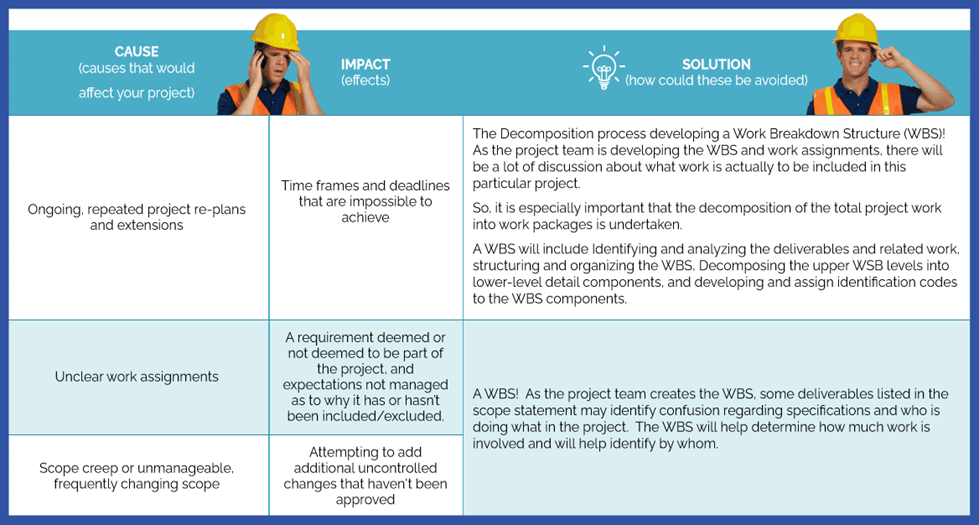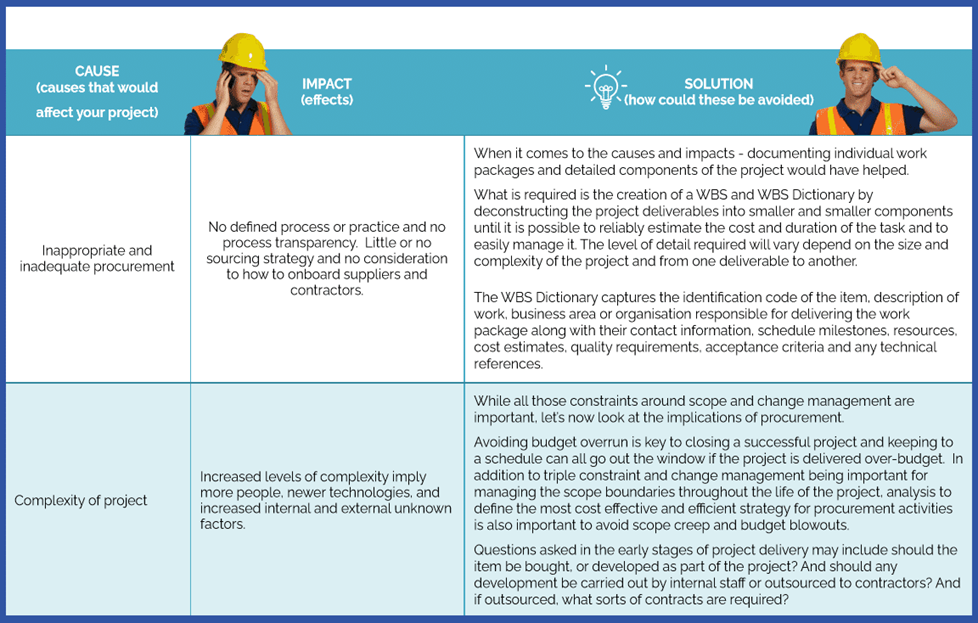Understanding
Project Deliverables Through Decomposition
Desmond Tutu
once wisely said, “There is only one way to eat an elephant: a bite at a time.”
What he meant is that everything in life that seems daunting, overwhelming, and
even impossible can be accomplished gradually by taking on just a little at a
time.
The secret
is to break down the big challenge into smaller, more manageable tasks. It’s
the same with any project – no matter how large and complex – it can be broken
down into a series of discreet tasks and deliverables that can be more easily
defined and managed. The breaking down of a project in this way is the process
of decomposition.
Proper
decomposition of a project is critical to one of the key roles of the Project
Manager – to manage scope.
Identify
the project.
The very
first thing to do when decomposing a project is to identify the project
deliverables or milestones. These deliverables will be the elements that you
will decompose and break down into tasks to produce work packages. To begin
with, the high-level deliverables are defined in a hierarchy.
Describe
the tasks in detail.
Then, each
deliverable and the tasks needed to create it are described in more and more
detail until it reaches a point where individual work packages can be
identified, described, scheduled, and costs & effort estimated. By this
point, we will know enough about each work package to be able to monitor and
control it.
Project
Milestone program
Eventually,
you will get to the position of being able to transfer this knowledge into a
Project Milestone program. Experience in this process is what the Project
Director uses to guide themselves early through the delivery of the project and
it is this process that will be used to inform the development of the project
schedule, the project budget, the project resourcing plan, and the overarching
project delivery plan. Failing to break down a project into all its deliverable
components may result in an important aspect of the project being
under-resourced or even unnoticed until it is only recognized after the time it
should have been commenced.
Identifying
Project Boundaries
Project
Boundaries provide a sense of direction and progress for the project. They
identify what is in and out of scope and assist in determining when one
milestone is achieved and the next one starts.
Project
boundaries are normally defined during the initiation phase of the project,
before detailed planning begins. As a Project Director on a major project, you
need to understand the boundaries of the project. The boundaries define the
deliverables and tasks that have been agreed upon with the Project Sponsor.
They will usually be defined in the service agreement between the Project
Manager and the Project Sponsor. The Project Director, if a technical expert
external to the business - in taking this role - has agreed to perform as part
of the contract between them and their client.
If you get
the opportunity to lead a large or high-profile project, don’t let it distract
you from the importance of knowing exactly what is in scope – if you fail to do
this, you may find yourself committed to far more hours than your service fees
cover and the project may run over time and budget because of scope creep and
constant changes as new elements get added throughout the delivery. However, if
the Project Director correctly establishes the scope and applies scope
management with the client - then the agreed scope and only the agreed scope is
performed. Changes requested by the client will be controlled and approved via
a change management process.
The
consequences of poor Scope Management can include a hit to the individual's
and/or organization's reputation, project cost overruns, project schedule
delays, demotivation of the project team, and sustainability risk to the
organization.
What could be
some examples of poor Scope Management that project teams have experienced?
Let’s look
at what happens when some of the main steps are missed. Here are some poor
Scope Management examples that often occur in projects. What could have been
done to avoid these issues!
POOR SCOPE
MANAGEMENT
Not applying
the work breakdown structure to the project management lifecycle.
Uncontrolled
changes are called ‘scope creep’ and are often the cause of project budget
overruns. A requirement management process seeks to prevent this from
happening. The causes/impacts and solutions involved with scope creep provide a
compelling argument for the analysis and application of project management
through rigorous Scope Management.
MORE
EXAMPLES ON POOR SCOPE MANAGEMENT
A WBS takes
large, complex projects and breaks down the overall scope into more manageable
pieces to make it easier to define, plan, schedule, and deliver.
Decomposing
Deliverables by Organizing the Work
Before the
deliverables make it into your Project Milestone program, they need to be
identified and then organized into logical groups, for example, project phases
or major deliverables.
Organizing
the work by granularity will make identifying, managing, and delivering the
work easier. It also illustrates likely areas of responsibility so you can make
sure all the right people have been involved in the work so far.
Each level
of granularity is noted as a ‘tier’. Tier 1 is the highest level and holds the
least amount of detail. It is numbered as follows: 1.0, 2.0, 3.0. As more
detail is introduced, the numbers reflect the new level as follows, defining
more detail in deliverable 2.0 is noted as 2.1, 2.2, 2.3, etc. when 2.1 is
reviewed further, tasks identified become 2.1.1, 2.1.2, 2.1.3, etc.
Developing
the Work Breakdown Structure (WBS) in this way will help define and capture the
full scope of the project and the effort required to deliver it in an organized
manner. It also improves communications with Stakeholders, Project Sponsor, and
Team Members, as well as helping to identify relationship constraints and
dependencies and enables more accurate estimation of costs, time/duration, and
risk.
The WBS
effectively defines the detailed scope of the project and the tasks required to
deliver it. At this point, the WBS should be cross-referenced to the contract
to ensure completeness of deliverables and the absence of scope creep.
Deal with
Each Deliverable Individually - Looking at Detailed Components
By dealing
with deliverables one by one, you eliminate confusion. During this step in the
process, each task identified in the WBS is analyzed in more detail and the
detailed activities are captured in a WBS Dictionary.
The project
team members or in the case of this scenario, the Project Director should
create the WBS and WBS Dictionary by deconstructing project deliverables into
smaller and smaller components until it is possible to reliably estimate the
cost and duration of the task and to easily manage it. The level of detail
required may vary depending on the size and complexity of the project and from
one deliverable to another.
The WBS
Dictionary captures the identification code of the item, description of work,
business area, or organization responsible for delivering the work package,
schedule milestones, resources, cost estimates, quality requirements,
acceptance criteria, and any technical references.
Developing
and assigning identification codes to the WBS components helps to identify the
relationships between tasks.
The Project
Director will commence on a drill-down. Drill down is a simple technique for
breaking complex problems down into progressively smaller parts. To use the
technique, the Project Director will start by writing the problem down on the
left-hand side of a large sheet of paper. A little to the right of this, write
down a list of points relating to the problem.
Once you
complete the first deliverable, repeat the process for the second, and so on,
until every deliverable and milestone has been broken down to sufficiently
estimate duration and cost.
Estimate
Durations and Arrange Tasks Into Work Packages
The steps in
this process are important because the documents created at this stage will be
used later in the costing and time management processes to schedule or plan the
tasks and to cost each element of the project to determine an overall project
cost.
A work
package is the lowest component in a work breakdown structure (WBS). A work
package is a group of related tasks within a project and is often thought of as
sub-projects within a larger project.
Estimate
Costs
Thoroughly
deconstructing project deliverables into smaller components enables reliable
cost estimation and management. Continue the breakdown of major elements until
adequate cost and duration estimates for each work package can be determined.
Organize the high level into a hierarchy to create the skeleton for the Work
Breakdown Structure.
Each
individual work package should be allocated to a Work Package Manager (WPM).
The WPM will define the work package in sufficient detail to be identified,
resourced, scheduled, and costs & effort estimated.
By
decomposing into work packages, the Project Lead will be able to budget the
project accurately. Failure to break a deliverable down into all its component
elements and tasks can result in a significant risk to a project being
overlooked until it’s too late.
For example,
a decision may be made to “buy-in” a premade piece of equipment, and its supply
may be arranged to coincide with the project's planned completion date without
full consideration of the physical time and effort required to complete the
installation and commissioning of the equipment, which can only occur after
other trades have completed their work and no other work is being undertaken.
The late realization of this work requirement can impact not just the delivery
time and installation of the equipment but also all the other trades that must
be finalized before the work can commence.
Some tasks
will have costs dependent upon the time; other tasks will require particular
resources that have a cost involved.
Understanding how a project
breaks down into a series of deliverables, which in turn are made up of a
series of tasks, is one of the key skills for a Project Manager. It makes the
project definition and delivery planning process possible. It helps identify
priorities, risks, and vulnerabilities and gives the Project Manager a
framework within which to manage scope and change and to deal with the many
pressures that impact a project throughout its lifecycle. A project without a
WBS is going to appear as indigestible as that elephant.














No comments:
Post a Comment